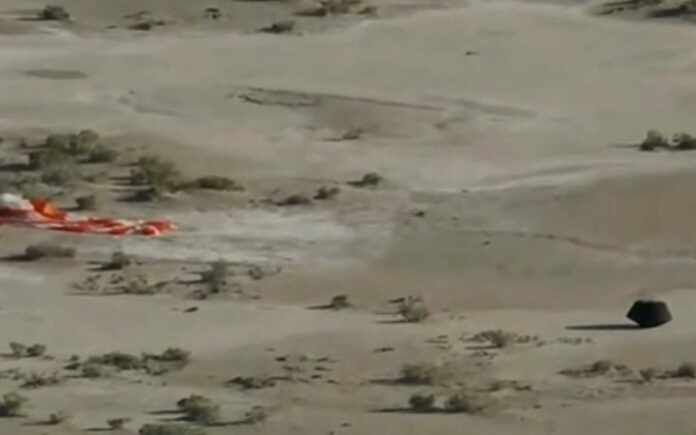Today, in the Utah desert, a seven-year mission to an asteroid named Bennu ended with a sample return capsule (seen above) returning to Earth containing 250 grams (8.8 ounces) collected from it.
The OSIRIS-REx mission whose long name is the Origins Spectral Interpretation Resource Identification Security Regolith Explorer began its journey from Earth in 2016 and arrived at Bennu in 2018 where it went into orbit around the asteroid. In 2020, Bennu rendezvoused with the surface in a touch-and-go 2-second manoeuvre (see image below) that collected samples of the asteroid’s regolith. It then began the journey back to Earth.
From the time of OSIRIS-REx launch, Bennu travelled from 225 million kilometres to 50 million kilometres (31 million miles) from Earth. The entire mission from liftoff to return covered 6.2 billion kilometres (4 billion miles).
NASA isn’t the first space agency to return a sample from an asteroid. JAXA, Japan’s space agency, in 2003 launched an asteroid sampling mission called Hayabusa. It rendezvoused with the asteroid Itokawa in 2005 and returned a very small sample to Earth in 2010. The sample from OSIRIS-REx is hundreds of times the size collected by Hayabusa.
OSIRIS-REx hasn’t finished its mission. The spacecraft has rendezvoused with Earth to deliver the sample return capsule and is now under a new mission name on its way to the asteroid Apophis which it will reach in 2029.
Now called OSIRIS-APEX which stands for OSIRIS-APophis EXplorer, it will study its new target, an asteroid that has a diameter of 370 metres (1,200 feet). Apophis is travelling towards Earth and will do a very close 2029 flyby of our planet, a mere 32,000 kilometres (about 21,000 miles) away. The spacecraft will begin orbiting Apophis soon after that flyby and will study it to see how the near rendezvous with Earth changed the asteroid in any way. It will then use its gas thrusters to dislodge dust and small rocks from the asteroid’s surface for study.
Apophis is a stony asteroid (S-asteroid) composed of silicates and nickel-iron, whereas Bennu is a B-asteroid rich in carbon and chemical compounds that may have been the materials found in the early Solar System that seeded our planet leading to the emergence of life.
The sample return capsule (see the image at the beginning of the article) weighs 46 kilograms (101 pounds) and is a design dating back to 1999. It features a cone that is 81 centimetres (approximately 32 inches) in diameter and 50 centimetres (about 20 inches) tall. Its components include an avionics and parachute system, a heat shield capable of withstanding reentry temperatures of 2,760 Celsius (5,000 Fahrenheit), a back shell and a canister inside where the Bennu samples were stored for the long journey back to Earth.
While writing this posting I have been watching the recovery of the sample return capsule from the Utah desert. It is now on its way to a temporary clean room nearby before being transported to the Johnson Space Center in Houston where sampling will begin early this week and continue for several years. A portion of the sample material will be shared with the Canadian Space Agency and JAXA. The bulk of the sample, however, will be stored for future technologies to study.
Besides studying asteroids to better understand the origins of the Solar System, an additional purpose is to improve Earth’s defence from rocks like Apophis which intersect closely with Earth such as will happen in 2029.
In 2022, NASA’s Double Asteroid Redirection Test (DART) mission impacted a small companion moonlet called Dimorphos that was circling the asteroid Didymos. The mission’s purpose was to begin testing a first line of planetary defence should a near-Earth asteroid threaten our planet in the future.










[…] sample from Bennu, an amount equivalent in weight to a regular bar of sap, was collected by NASA’s Osiris Rex mission when it rendezvoused with the asteroid in 2018. In September 2023, it made it back to Earth. What […]